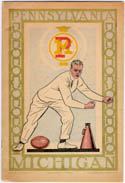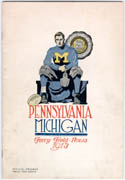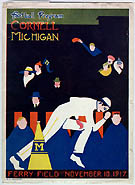| Michigan Agricultural College (MAC, later Michigan State University) remained on the Michigan schedule as the MAC was not yet a member of the Western Conference. But in the Wolverines' eyes the Aggies still represented a "minor" game and the programs reflected that status. The simple, 16-page, pamphlet-sized programs were printed on newsprint quality paper with only a few images. For games played in Lansing, the MACers generally produced a fancier program. Not until 1918, when MAC played in Michigan's homecoming, was there a full-sized program for the intrastate game in Ann Arbor.
|

Penn, 1911 |
Michigan had made a few forays into the East before 1906 - a four-game trip in 1883 to play Wesleyan, Harvard, Yale, and Stevens in a nine-day span, a trip to Harvard in 189, a series of games against Cornell in the 1890s and two trips to Philadelphia to face Penn. While controversy raged on campus and among the alumni over the question of leaving the conference, athletic directors Charles Baird and Phil Bartelme were forced to look East for top level competition. Cornell, Pennsylvania and Syracuse became fixtures on the Wolverines schedule.
Three of the most distinctive program covers from the decade were the work of U of M students. John H. Meier, an Ann Arbor native, created the cover for the 1911 Penn program. Meier attended the Chicago School of Fine Arts before enrolling in U of M department of architecture in 1910. He also designed the covers for the original editions of the sheet music for "Varsity" and the "Yellow and Blue." Meier was later head of the art department for James Bayne Engraving Company of Grand Rapids.
Reed E. Bachman, '20 LS&A, probably came close to the day's ideal of the college man. He belonged to a prominent social fraternity, two professional fraternities, two of the campus secret honorary societies, was an artist and editor for three campus publications, served as an assistant football manager and even acquired a nickname - "Goat." His cover for the 1917 Cornell game is surely one the most interesting ever produced. Along with his 1919 Minnesota program, its bold colors and sharp contrasts set the stage for a wholly new style of cover art in the 1920s. Bachman went on to a highly successful career as a commercial illustrator.
|

Cornell, 1915

Penn, 1915 at Philadelphia
|













